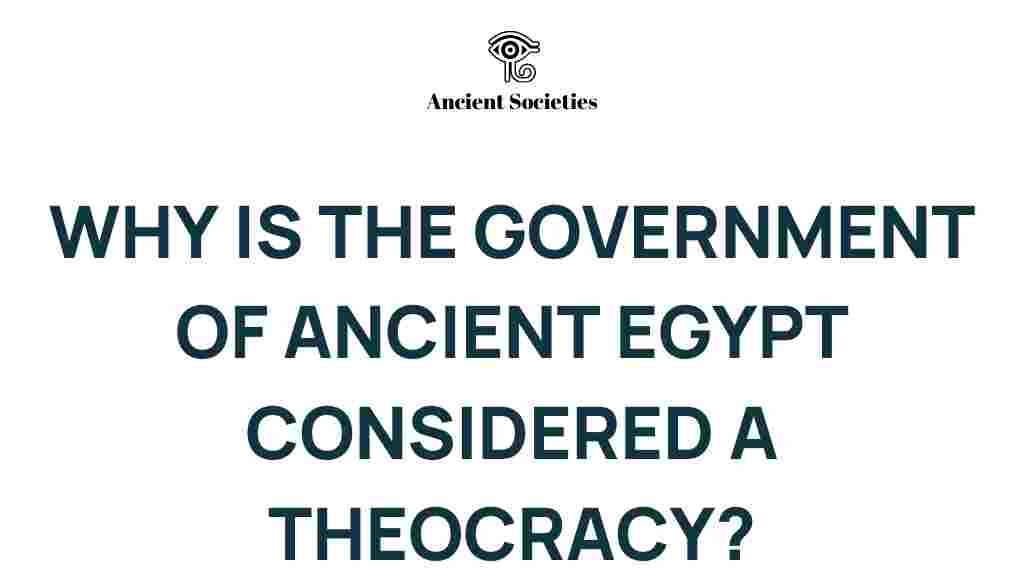Unveiling the Theocratic Mystique of Ancient Egypt’s Governance
Ancient Egypt is often remembered for its monumental architecture, rich mythology, and fascinating history, but at the heart of its society lay a complex system of governance deeply intertwined with religion. The theocracy of Ancient Egypt established a unique relationship between the state and the divine, creating a governance structure that not only maintained power but also reinforced the cultural and spiritual beliefs of its people. In this article, we will explore the intricacies of Ancient Egypt’s governance, the role of pharaohs, and how religion shaped the society and culture of this remarkable civilization.
The Foundations of Theocratic Governance in Ancient Egypt
The theocracy of Ancient Egypt was characterized by a system where the pharaoh was regarded not only as a political leader but also as a divine entity. This belief in the divine right of kings meant that the pharaoh was seen as the intermediary between the gods and the people. The governance structure in Ancient Egypt was thus a blend of political and religious authority, creating a unique form of theocracy.
- Pharaohs as Divine Rulers: Pharaohs were considered gods on earth, embodying both the divine and human elements of governance.
- Religious Institutions: Temples and priesthoods played vital roles in administration, acting as centers of power, wealth, and education.
- Cultural Integration: Religion permeated everyday life, influencing laws, social norms, and even economic practices.
The Role of Religion in Governance
Religion was not merely a set of beliefs in Ancient Egypt; it formed the backbone of governance. The state’s laws and policies were often justified through religious doctrine.
- Legitimization of Power: Pharaohs claimed their authority through divine lineage, often tracing their ancestry to gods such as Ra and Osiris.
- Religious Festivals: National events were heavily tied to religious observances, reinforcing the connection between the state and the divine.
- Moral Code: The concept of Ma’at, representing truth and order, guided the legal and ethical frameworks of society.
The Structure of Governance in Ancient Egypt
The governance of Ancient Egypt was highly centralized, with the pharaoh at the top of the hierarchy. Below the pharaoh were various officials who aided in the administration of the state.
- Vizier: The chief minister responsible for overseeing the administration, law, and order.
- Nomarchs: Governors of regions (nomes) who managed local affairs and reported directly to the pharaoh.
- Priesthood: High priests held significant power, managing temples and religious practices that reinforced the pharaoh’s authority.
Pharaohs: The Epitome of Power
Pharaohs were not just rulers; they were central figures in the religious and cultural life of Ancient Egypt. Their power was both reverent and absolute, which was manifested in various ways:
- Architecture: The construction of monumental structures like the pyramids and temples was a display of power and divine favor.
- Military Leadership: Pharaohs led military campaigns to expand territory and secure resources, further solidifying their role as protectors of the nation.
- Divine Connection: The belief that pharaohs could intercede with the gods for the people reinforced their power and status.
Societal Impact of Theocratic Governance
The theocratic governance in Ancient Egypt created a highly stratified society where religion and power intermingled. This societal structure had profound effects on its culture and daily life:
- Social Hierarchy: Society was divided into classes, with the pharaoh and priests at the top, followed by nobles, artisans, farmers, and slaves.
- Cultural Practices: Religious rituals, festivals, and customs shaped the cultural landscape, influencing art, music, and literature.
- Education and Knowledge: Temples served as centers of learning, preserving knowledge that would influence future cultures.
Understanding the Theocratic Mystique
To truly appreciate the theocracy of Ancient Egypt, one must understand the symbiotic relationship between governance and religion. This relationship provided stability and continuity for thousands of years, but it was not without its challenges.
Challenges Faced by Theocratic Governance
Over the centuries, Ancient Egypt faced numerous challenges that tested the resilience of its theocratic system:
- Foreign Invasions: The rise of foreign powers often threatened the stability of the pharaonic rule.
- Internal Strife: Power struggles among the elite and disputes over succession could lead to periods of unrest.
- Religious Reforms: Movements such as that of Akhenaten, who attempted to shift worship to a single deity, disrupted traditional practices.
The Legacy of Ancient Egypt’s Theocratic Governance
The governance system in Ancient Egypt left a lasting impact on subsequent civilizations. Its blend of religion and politics influenced various cultures throughout history:
- Influence on Religion: Many aspects of Egyptian mythology and religious practices were adopted and adapted by neighboring cultures.
- Legal Systems: The principles of Ma’at inspired later legal frameworks, emphasizing justice and order.
- Architectural Innovations: The monumental constructions of Ancient Egypt set a precedent for future architectural achievements.
Conclusion: The Enduring Mystique of Ancient Egypt
The theocratic governance of Ancient Egypt was a fascinating interplay of religion, culture, and power that shaped one of history’s most enduring civilizations. The pharaohs, as both political and divine figures, commanded immense authority, supported by a complex bureaucratic system that integrated religious beliefs into the fabric of society.
As we continue to explore the history of Ancient Egypt, it becomes clear that understanding its theocracy provides invaluable insights into the development of governance systems throughout the ages. The legacy of Ancient Egypt’s governance can still be seen today, inspiring awe and curiosity in those who seek to uncover the mysteries of this ancient civilization.
To learn more about the ancient world, visit this resource on historical governance systems.
For a deeper dive into the cultural aspects of Ancient Egypt, check out this article that explores its art and architecture.
This article is in the category History and created by AncientSocieties Team

1 thought on “Unveiling the Theocratic Mystique of Ancient Egypt’s Governance”